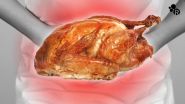(Press-News.org) Conventional treatment seeks to eradicate cancer cells by drugs and therapy delivered from outside the cell, which may also affect (and potentially harm) nearby normal cells.
In contrast to conventional cancer therapy, a University of Cincinnati team has developed several novel designs for iron-oxide based nanoparticles that detect, diagnose and destroy cancer cells using photo-thermal therapy (PTT). PTT uses the nanoparticles to focus light-induced heat energy only within the tumor, harming no adjacent normal cells.
The results of the UC work will be presented at the Materials Research Society Conference in Boston Nov. 30-Dec. 5 by Andrew Dunn, doctoral student in materials science engineering in UC's College of Engineering and Applied Science. Working with Dunn in this study are Donglu Shi, professor of materials science engineering in UC's College of Engineering and Applied Science; David Mast, associate professor of physics in UC's McMicken College of Arts and Sciences; and Giovanni Pauletti, associate professor in the James L. Winkle College of Pharmacy.
The UC study used the living cells of mice to successfully test the efficacy of their two-sided nanoparticle designs (one side for cell targeting and the other for treatment delivery) in combination with the PTT. However, the U.S. Food and Drug Administration has now approved the use of iron-oxide nanoparticles in humans. That means the photo-thermal effect of iron-oxide nanoparticles may show, in the next decade, a strong promise in human cancer therapy, likely with localized tumors.
HOW THE NANOPARTICLES WORK WITH PHOTOTHERMAL THERAPY
With this technology, a low-power laser beam is directed at the tumor where a small amount of magnetic iron-oxide nanoparticles are present, either by injecting the particles directly into the tumor or injecting them into the blood stream whereby the particles find and bind to the abnormal cancer cells via cell-specific targeting.
Sufficient heat is then generated locally by the laser light, raising the tumor temperature rapidly to above 43 degrees Celsius, and thereby burning the abnormal cancer cells. This particular PTT treatment does not involve any medicine, but only generates local heat within the tumor, therefore posing much less side effects than the traditional chemo or radiation therapies.
"This treatment is much more ideal because it goes straight to the cancer cell," says Shi. "The nanomaterials enter only the abnormal cells, illuminating those cells and then doing whatever it is you have designed them to do. In this case, it is to heat up hot enough to burn and kill the cancer cells, but not harm the surrounding normal cells."
Shi added that physicians are often frustrated with the current conventional means for early imaging of cancer cells through Medical Resonance Imaging or Computerized Tomography scans because the tumors are usually stage three or four before they can be detected. He stated, "With nanomaterial technology, we can detect the tumor early and kill it on sight at the same time."
CELL TARGETING
Each tumor has a corresponding protein that is cancer specific called a tumor specific ligand or an antibody antigen reaction that only has expression for that specific cancer such as breast or prostate cancer.
Scientists identify this certain bio-marker that is specific to a certain tumor, then conjugates this bio-marker on the surface of the nanocarrier that only has the expression for that specific kind of cancer cell.
It then only targets the abnormal cancer cell, not normal, healthy cells, and because it is so small it can break the membrane and enter that conjugated cancer cell and release the PTT.
The nanotech carriers go into the body through a vein in the blood stream, seek the abnormal cancer cells, find the bio-marker or cancer cells and attach to those cells and unlock their florescent particles so they can be detected by a photon laser-light.
The laser-light heats the nanoparticles to at least 43 degrees Celsius to kill the cancer cells, ultimately leaving all the other cells in the body unharmed.
POTENTIAL DIY CANCER TREATMENT
The procedure can ultimately be carried out by the patient themselves after being trained how to direct a small laser light device to the affected area for a specified amount of time two to three times a day. This method can ultimately improve the success rate, as well as cut costs to the patient. This gives "point and shoot" a whole new meaning.
FUTURE RESEARCH DIRECTION
Future research in nanoparticle PTT will look at toxicity, biodegradability and compatibility issues. Shi said that the team is currently looking for other diverse biodegradable materials to use for the carriers such as plant chlorophylls like those in cabbage that are both edible and photothermal. This material is biocompatible and biodegradable and can potentially stay in the tumor cells until its job is finished, then dissolve and be passed out through the digestive system.
INFORMATION:
Support for this research was provided by a National Science Foundation grant under contract number MSF (1343568) titled "Development of Nanotechnology Minor Focused on Nano Biomedicine and Sustainable Energy."
Scientists from the US Department of Energy's Lawrence Berkeley National Laboratory (Berkeley Lab) have learned new details about how an important tumor-suppressing protein, called p53, binds to the human genome. As with many things in life, they found that context makes a big difference.
The researchers mapped the places where p53 binds to the genome in a human cancer cell line. They compared this map to a previously obtained map of p53 binding sites in a normal human cell line. These binding patterns indicate how the protein mobilizes a network of genes that quell tumor ...
Researchers at UC San Francisco have identified patterns of genetic activity that can be used to diagnose endometriosis and its severity, a finding that may offer millions of women an alternative to surgery through a simple noninvasive procedure.
The study is online in the journal Endocrinology.
"This promising molecular diagnostic approach would not have been possible without advances in genomics and bioinformatics," said senior author Linda Giudice, MD, PhD, distinguished professor and chair of obstetrics, gynecology and reproductive sciences at UCSF.
"Importantly, ...
A protein that stimulates the brain to awaken from sleep may be a target for preventing Alzheimer's disease, a study by researchers at Washington University School of Medicine in St. Louis suggests.
In recent years, scientists at Washington University have established links between sleep problems and Alzheimer's. For example, they have shown in people and in mice that sleep loss contributes to the growth of brain plaques characteristic of Alzheimer's, and increases the risk of dementia.
The new research, in mice, demonstrates that eliminating that protein - called orexin ...
WASHINGTON, Nov. 24, 2014 -- The season of giving is often also the season of over-indulging at the dinner table. As Thanksgiving approaches, Reactions takes a look down at our stomachs to find out what happens when you overeat. Put on your "eating pants" and enjoy the video here:
Subscribe to the series at Reactions YouTube, and follow us on Twitter @ACSreactions to be the first to see our latest videos.
INFORMATION:The American Chemical Society is a nonprofit organization chartered by the U.S. Congress. With more than 161,000 members, ACS is the world's largest scientific ...
How does glass transition from a liquid to its familiar solid state? How does this common material transport heat and sound? And what microscopic changes occur when a glass gains rigidity as it cools?
A team of researchers at NYU's Center for Soft Matter Research offers a theoretical explanation for these processes in Proceedings of the National Academy of Sciences.
Our understanding of glasses as they change state is relatively limited. This is because, unlike other materials such as metals, their constituent particles--which can be as small as a billionth of a meter ...
People who see their group as more homogenous - for instance, the more one thinks Americans are similar to each other - are less likely to be influenced by external terrorist threat alerts, according to research from NYU's Steinhardt School of Culture, Education, and Human Development.
"Among people who viewed their group to be homogeneous, external threat did not translate to higher perceived threat, and they did not influence beliefs about the legitimacy of the U.S. military intervention in Iraq," said study author Rezarta Bilali, assistant professor of psychology and ...
ANN ARBOR--The medical community may be inadvertently creating a new generation of illegal, recreational drug users by prescribing anti-anxiety or sleep medications to teenagers, say University of Michigan researchers.
Teens prescribed anxiety or sleep medications are up to 12 times more likely to abuse those drugs than those who had never had a prescription, either by using someone else's prescription pills or to get high or experiment, according to a study from the U-M School of Nursing.
Nearly 9 percent of the 2,745 adolescent study participants had received ...
A team of scientists from Arizona State University's Biodesign Institute and IBM's T.J. Watson Research Center have developed a prototype DNA reader that could make whole genome profiling an everyday practice in medicine.
"Our goal is to put cheap, simple and powerful DNA and protein diagnostic devices into every single doctor's office," said Stuart Lindsay, an ASU physics professor and director of Biodesign's Center for Single Molecule Biophysics. Such technology could help usher in the age of personalized medicine, where information from an individual's complete DNA ...
SAN FRANCISCO (November 24, 2014) --A team of scientists, including researchers from the California Academy of Sciences, has reconstructed a detailed "tree of life" for turtles. The specifics of how turtles are related--to one another, to other reptiles, and even to dinosaurs--have been hotly debated for decades. Next generation sequencing technologies in Academy labs have generated unprecedented amounts of genetic information for a thrilling new look at turtles' evolutionary history. These high-tech lab methods revolutionize the way scientists explore species origins and ...
Members of the public in sub-Saharan Africa who are carriers of the hereditary disease sickle cell disease must be educated aggressively through public health campaigns to raise awareness of the risks of parenting offspring with the disease if their partner is also a carrier, according to research published in the International Journal of Medical Engineering and Informatics.
There are many physical and emotional public health components of sickle cell disease, explains William Ebomoyi of the Department of Health Studies College of Health Sciences, Chicago State University, ...



